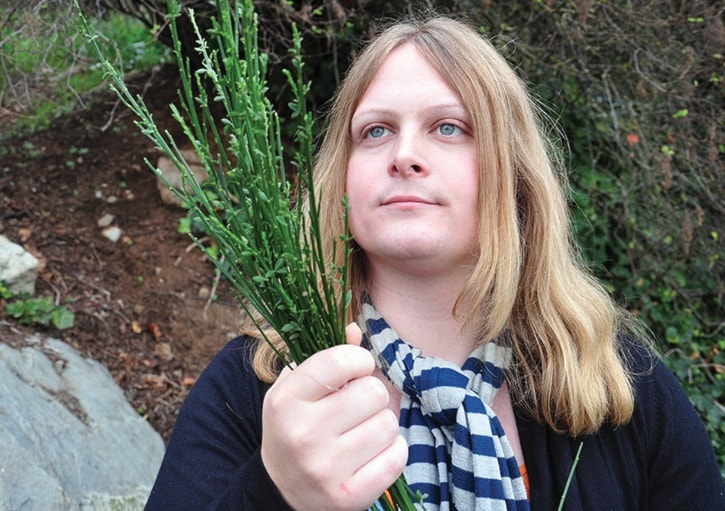Every fall for more than a decade, helicopters have buzzed Mill Hill park to airlift away great mounds of Scotch broom.
Volunteers and staff clip the shrub by hand, a laborious process for a war on invasive plants that has seen small victories, but still has no end in sight.
Controlling invasive plants in Greater Victoria has often been a choice between years of hard manual labour or years of chemical treatment. Two University of Victoria biology graduates are developing a third option – a biotechnology that could flick a "kill" switch within a plant's genetic code. Potentially, the treatment could precision target specific invasive species, and without harming neighbouring native plants or animals.
"Our roommate in environmental studies always suggested problems for us to solve. That led us down this path," said Chris Tuttle, who with Layne Woodfin, have created Cotyledon Consulting.
UVic's Innovation Centre for Entrepreneurs helped Tuttle and Woodfin refine their business plan, which is focused on defeating kudzu, an aggressive vine that has choked vast areas of the U.S. southwest. Both scientists are based in Victoria, but they've set up what they call a "DIY" laboratory in Port Alberni – due to the low rental cost – to refine their genetic technology.
"We are seeking a clear proof of concept by April. For business development we are looking at kudzu in the U.S. because the Scotch broom market is small," Tuttle said. "If we can find funding here, we'd love to focus on Scotch broom."
The basis of the technology is called RNA interference or RNAi, relatively young field of biology that uses short strands of genetic material to deactivate specific genes within the DNA of certain organisms. This has proved extremely handy in understanding how genes work, and earned a Nobel Prize for the scientists who discovered it.
Tuttle and Woodfin are developing RNAi techniques to target genes unique to a specific invasive plant, and that would effectively turn off the plant's ability to process nutrients, killing it and halting the ability for its seeds to germinate. Part of the development process is testing the safety and efficacy of RNAi strands, although Tuttle said its not something that can transfer between plants or other organisms.
"We're not infecting the plant – the contagion is RNA used to reprogram the plant's current state," she said. "(Herbicides such as) Roundup goes after a protein that makes nutrients in a plant, that without it would die. It blocks that protein. But with ours we'll prevent that protein from being built in the first place."
Developing genetic technology has become far more viable for startup companies due to the steep drop in price and fast turnaround for sequencing and creating synthetic strands of DNA. Cotyledon would need to sequence kudzu DNA, for example, to understand how to construct interfering RNA.
"Without making light of their skills, timing is everything. They wouldn't have been able to do this 20 years ago," said Anne Flanagan, a scientific advisor for Cotyledon and a patent agent based in Sidney. "(DNA) sequencing is now dirt cheap. Things that used to take a week now take half an hour."
Cotyledon has access to up to $93,000 from the National Research Council's Industrial Research Assistance Program, but in terms of a biotechnology company, it's on a shoestring budget. Still, it has managed to file for two technology patents.
Flanagan said she's encouraging Tuttle and Woodfin to develop their prototype as fast as possible due the high cost of privately-funded scientific research. Equipment and experimental materials aren't cheap, but the potential market for highly targeted herbicides is vast.
"If you're talking invasive species, that includes weeds on farmers' fields. That is a multi-billion dollar market. And it would be nice to get away from chemicals," said Flanagan, a retired biotechnology professor from the University of Alberta.
"Kudzu is a good example of a species that could be controlled. They need a species they can monetize the technology around, and kudzu allows that. But once the technology is in place, the applications are limitless. It can be used on any plant species any place in the world."
Saanich alone spends about $200,000 per year on controlling invasive species and environmental restoration. Volunteers dedicate some 8,000 hours per year hand-cutting invasives across 40 parks. For hearty invasives like knotweed, Saanich injects a herbicide into its stems, which doesn't always work. "Even then, it's a two or three year program to get full control," said Cory Manton, Saanich's manager of parks and natural spaces.
Flanagan said the likely business path for Cotyledon is licensing the technology to a larger company, which could take on regulatory hurdles. "It gets (Cotyledon) a revenue stream and allows them to get onto the next technology. They've got a lot of ideas. This is the first one," she said. "But they've got to prove the concept and prove to the world they are capable of this."
Martyn Ward, an industrial technical advisor for the NRC's Industrial Research Assistance Program, which helps fund technology startups, said the Cotyledon project is intriguing and that Tuttle and Woodfin "appear to know their subject matter very well."
"If they succeed, there are plenty of opportunities for controlling invasive species," said Ward, who is based at the NRC office on Observatory Hill, a property with its fair share of broom. "If they develop the technology and then find a channel to market it, which is always a challenge, they could do very well."
editor@saanichnews.com
